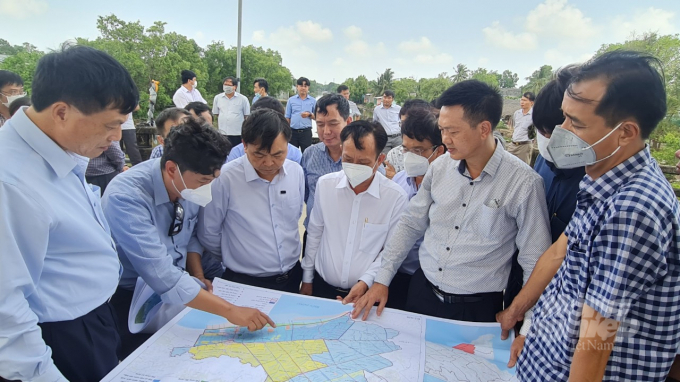November 27, 2025 | 07:05 GMT +7
November 27, 2025 | 07:05 GMT +7
Hotline: 0913.378.918
November 27, 2025 | 07:05 GMT +7
Hotline: 0913.378.918

Deputy Minister Nguyen Hoang Hiep and the delegation survey the site of the project "System of works to regulate and replenish water for aquaculture in the south of National Highway 1A, Bac Lieu province". Photo: Trong Linh
A delegation of the Ministry of Agriculture and Rural Development led by Deputy Minister Nguyen Hoang Hiep on April 18 had a working session with the People's Committee of Bac Lieu province on the project "A system of works to regulate and supplement water for aquaculture in the south of National Highway 1A, Bac Lieu province". The project has been approved by the ministry with a total capital of more than VND1.5 trillion.
This is a very important project for the socio-economic development of Bac Lieu province in the period of 2022 - 2025, with a vision to 2030-2050. The project's beneficiary area includes a part of Bac Lieu City and districts of Vinh Loi, Hoa Binh and Dong Hai and Gia Rai town. The total area is more than 63,000 hectares, including more than 43,000 hectares of aquaculture.
The proposed construction solutions are self-flowing water transfer combined with pumping and closing the project area by tidal control sluices. Accordingly, two sluice gates will be built at Vam Leo and Ho Phong, and nine open sluices will be built on the east bank of Ho Phong - Ganh Hao canal. The project also includes the repairing and upgrading of Cau Sap sluice and the construction of Cau Sap pumping station.
The project will faciliate the fresh water transfer from the North of National Highway 1A to the Southern of the highway to dilute the water source to ensure aquaculture for an area of 46,300 ha.
At the same time, under the project, saltwater would be minimised before the time of sowing to serve rice cultivation for the area of about 15,000 hectares of rice-shrimp area.
The project will enhance the ability to exchange water sources, actively remove polluted water, supply sea water of good quality, contributing to reducing water pollution in the river and canal system that provide water for aquaculture. It also helps reduce flooding, protect infrastructure against negative impacts of nature, reduce groundwater exploitation, land subsidence, sea level rise.
It is also expected to support water drainage to reduce flooding for the North National Highway 1A area in Bac Lieu province with an area of about 42,000 ha.
Deputy Minister Nguyen Hoang Hiep said that Bac Lieu province was assigned by the Prime Minister to become the centre of the country's shrimp industry. To realise it, there must be good irrigation infrastructure.
In the past time, the Ministry of Agriculture and Rural Development invested in many irrigation projects in the province such as Ninh Quoi boat dock, Ganh Hao fishing port, Bac Lieu high-tech agricultural application and shrimp development area.
With the project "System of works to regulate and supplement water for aquaculture in the south of National Highway 1A, Bac Lieu province" which is about to be implemented, Bac Lieu province will be more proactive in water sources for production in both regions - North and South Highway 1A.
However, because there are many different opinions, the Ministry of Agriculture and Rural Development want to learn more opinions from local authorities, professional agencies and scientists.
Translated by Hien Anh
/2025/11/26/4909-2-154329_878.jpg)
(VAN) Pearl grouper farming in HDPE cages not only delivers economic efficiency but also contributes to protecting the environment, creating jobs, and promoting marine-based experiential tourism.

(VAN) The model of making a living under the forest canopy through the agroforestry system in Van Son commune, Bac Ninh province, is expected to generate an annual income of approximately VND 30 million/ha.

(VAN) Many enterprises in Can Tho are harnessing natural energy and reducing greenhouse gas emissions in their production processes, thereby contributing to the promotion of a sustainable green transition.
/2025/11/24/3536-2-112800_176.jpg)
(VAN) Dong Nai now has tens of thousands of hectares of forests certified for sustainable management, and this area will continue to be expanded in the coming period.

(VAN) Vinh Ha hamlet (Dai Xuyen commune, Hanoi) is shifting away from small-scale farming as households adopt bioscurity into their breeder chicken models.

(VAN) Heavy rains make aquatic species more vulnerable to disease. Proactive water management and high-tech systems help farmers prevent outbreaks and protect yields.

(VAN) Greenhouses are shifting production mindsets in Binh Lu commune, enabling farmers to ‘weather the sun and rain’ and secure stable vegetable harvests throughout the year.